Recent Articles
Popular Makes
Body Types
Tire Sense
Choose the best tire to suit your needs
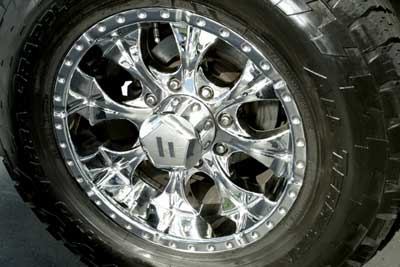
Choosing the right tires for your ride isn't easy - and may well be quite a bit more important than you think. Whether it's all-season tires, truck tires or highway tread, plus sizing tires or choosing snow tires, each tire performs in a specific way, and your choice will determine whether you maximize the enjoyment and longevity of your ride. Consider these criteria in helping to determine what tire you should purchase. For instance, if you drive a sedan year-round on highways and experience very little winter weather, shop for a long lasting all-season tire that won't have an aggressive tread design. A tire of this nature delivers good traction in moderate weather, lasts 40 to 50 thousand miles (providing the alignments and rotations are performed), and offers a relatively quiet ride.
Tire treads
If you're shopping with a working pickup truck in mind, you should of course purchase truck tires, as they are typically made with a heavier body with multiple plies, or layers (sometimes steel plies), stronger sidewalls for resistance to impact breaks, and deeper tread with a heavier rubber compound. Usually the tread design on truck tires is aggressive and gives great traction in mud and snow. On the down side, a tire of this type is usually quite noisy and provides a stiff, hard ride. Let's say you drive your car only in good weather; or perhaps it is a collector car. In this situation, a highway tread is your best choice. The tread design is ribbed, and straight grooves are cut into the rubber evenly around the circumference of the tire. If you were trying to pull through snow with these tires it would be like trying to climb a mountain in high heels -- impossible! But on clear roads they deliver a smooth, quiet ride.
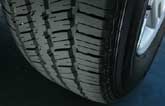
Grading system
If you want to feel confident choosing the best tires for your needs, learn how to read the Uniform Tire Quality Grading System (UTQGS). The UTGQS information is molded onto the sidewalls of the tires. This system grades tires on three factors: Tread wear, traction, and temperature resistance.- This grade gives a comparative rating based on the wear rate of a tire when tested under carefully controlled conditions. For example, a tire graded at 200 should have its useful tread twice as long as a tire graded at 100. Obviously, tire life (in miles) varies depending on actual driving conditions. Variation in driving habits, service applications, attention to proper maintenance (rotation, wheel alignment, maintaining air pressure), and road conditions all contribute to tread wear. - Traction grades represent the tire's ability to stop on wet pavement as measured under controlled conditions on asphalt and concrete. The traction grades from highest to lowest are: "AA," "A," "B," and "C." A tire graded "AA" may have relatively better traction performance than a tire graded "A," "B," or "C," based on straight-ahead braking tests. The grades do not reflect cornering or turning traction performance of the tires. - This grade reflects the tire's resistance to heat as well as its ability to dissipate heat. Sustained high temperatures can cause decreased tire life or sudden tire failure. The grades from highest to lowest are: "A," "B," and "C." "C" grade represents the absolute minimum requirements by federal standards. This grading is based on proper inflation of the tire, proper mounting on the rim, and the assumption that the tire's load is within its capacity. Excessive speed, under inflation, and overloading (separately or in combination) can cause excessive heat buildup and possible tire failure.
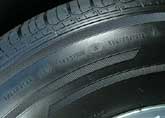
All-Season
All-season tires have two major characteristics:1. A tread design that disperses weather elements (i.e.: rain, snow, slush, mud) out from under the footprint of the tire. If you were to observe a typical all-season tread design under a slow-motion camera as it rolls down the road, you would see that it actually performs two functions. It squeegees the road and it pumps water, snow, and slush from under the tire's footprint, providing maximum tire-to-road traction.
2. All-season tires are made of a rubber compound that does not freeze in temperatures below freezing. This characteristic is essential for the pumping and squeegee actions described above.

Plus sizing
The big craze today is plus-sizing tire/wheel combinations, commonly referred to as installing "dubs." A typical dub application might be to go from a 17" tire/wheel combo to a 22" setup. This kind of setup allows you to move to a wider footprint tire with a larger diameter rim (usually quite flashy or with spinner hubcaps). There are two factors to consider when making this kind of a move: · Make sure the new tire is not too wide. If the tire is too wide, it might not clear critical suspension and steering components. In addition, the tire could rub or scrape against body panels, causing the early demise or your expensive dubs! Careful measurement before installation is critical. Measure and re-measure! It might take a little extra time but could save you significant expense. · Make sure the overall diameter of the new tire/wheel combo is very close to the original configuration (ideally, it should be exact). If the change is too drastic, the speedometer and vehicle performance computer will be thrown out of kilter. The computer receives critical information from speed sensors, and this info is used by the performance computer to determine fuel delivery, ignition, and transmission shift strategy.

Snow tires
For those who live in winter climates, you want maximum traction in snow, so install snow tires at all four corners of the vehicle. This will give you maximum traction in all winter conditions. On a front wheel drive vehicle, if you install snow tires only on the front, you will find that while cornering, the rear of the vehicle may fish tail. On a rear wheel drive vehicle the opposite is true. On four-wheel drive vehicles, four snow tires makes for sure footed traction in all winter conditions.
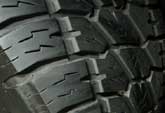
Tips 1 & 2
You spend a lot of money on tires, so you want them to last! To get the most mileage out of them, do the following: Rotating and re-balancing your tires every 6,000 miles or six months will maximize tire life and minimize wear to the shocks and struts. Tires are made out of rubber and naturally wear with use, and each tire has a different wear factor depending on its mounted position on the car. Rotating the tires every 6,000 miles or six months gives each tire equal time at each position on the car, minimizing wear. It is important to re-balance the tires every time they are rotated. When the tire is new, it is balanced based on the mass of rubber present at that time. As the tire wears down, the rubber mass diminishes, throwing off the balance. This causes a tramping, or bouncing effect as the tire rolls down the road at highway speeds. This motion creates a choppy wear on the tread, causes tire noise, and escalates wearing. It also causes premature wearing of the shocks and struts! Regular alignment checks and adjustments every year or 12,000 miles will maximize tire life. The alignment angles in your car's front and rear end change as parts wear and poor road conditions jostle the suspension. On cars with 4-wheel independent suspension or front wheel drive, get a 4-wheel alignment, as these cars have adjustable alignment angles at each wheel that are affected by the same forces.. When the rear or front wheels are out of alignment, the tires try to track against each other. This causes pulling, drifting, dog tracking (the rear of the car don't accurately follow the front), and excessive tire wear.

Tips 3 & 4
Regular air pressure checks and adjustments will maximize tire life, as improper air pressures can wear tires. When a tire is under-inflated, the center of the tread will "bow" inward, causing excessive wear on the outside treads. When a tire is over-inflated, the center of the tread will "bow" outward, causing wear on the center of the tire's tread. Air pressure varies with temperature and poor tire condition; also, excessive weight can necessitate the use of more air in the tires. So regularly check tire pressures and, if you must carry additional weight, check the tire manufacturer's recommended air pressure adjustments. Keeping the steering and suspension systems in good working order will maximize tire life. When you have the vehicle aligned, have these components checked for integrity. An alignment is only as good as the parts you're aligning, after all, and a technician can spend all day setting a front end to perfect specs -- only to find that the alignment is worthless.
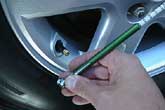
Tip 5
Keeping fresh shocks and struts on your car will maximize tire life. The purpose of the shock absorbers and struts are to dampen spring oscillation. Without them, the wheels would be allowed to bounce their merry way down the road, allowing your poor tires to wear out prematurely. Additional wear will also take place on related components. Follow these care and shopping tips when it comes to your vehicle's tires, and you'll find that the right tires produce a safe, effective, and comfortable ride. And don't forget: proper tire maintenance prevents wear and tear on more than just your tires … and that puts money in your pocket!
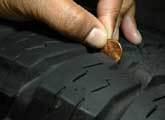
Maximize Tire Life
Tire tip #1: Rotating and re-balancing your tires every 6,000 miles or six months will maximize tire life and minimize wear to the shocks and struts. Tire tip #2: Regular alignment checks and adjustments every year or 12,000 miles will maximize tire life. Tire tip #3: Regular air pressure checks and adjustments will maximize tire life.Sidebar: Tire tip #4: Keeping the steering and suspension systems in good working order will maximize tire life. Tire tip #5: Keeping fresh shocks and struts on your car will maximize tire life. --Photos by Erik Hanson